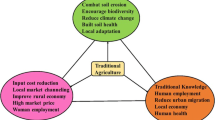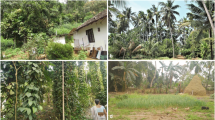Abstract
This study was conducted in the Banni region of the Gujarat State, India, which is located in the western-most end of the country. The main objective was to investigate the local perceptions of grassland change, regeneration potentiality, socio-economic status and factors that cause degradation of the vegetation resources in Banni. Participatory Rural Appraisal (PRA) was employed to generate the socio-economic profile of interviewed villages or hamlets. Information on vegetation deterioration and changes in species composition significant for sustainable management of grassland was obtained through interviews with 51 elderly maldharies (pastoralists) and local inhabitants living in 31 villages in Banni. Local people had observed a change in the local surrounding habitats from grassland to woodland (dominated by Prosopis juliflora, locally called Gando Bavar) during their lifetime and considered it primarily a result of frequent intensive drought, constructed dams on flooding rivers in Banni, and declining rainfall. The socio-economic survey showed that the Banni communities are highly dependent on the natural grassland for various purposes. In particular, nine woody species were useful for construction of the traditional house called Bhunga, four for medicine and 22 for livestock fodder. Highly preferred and declining species were characteristically large wild thorny trees with edible fruits, viz. Acacia nilotica subsp. indica (Bavar), Prosopis cineraria (Kandho), and Salvadora persica (Kharijar). Some of the locally highly preferred grass species were also considered to be declining in the local environs; they included Dichanthium annulatum (Jinjvo), Cenchrus ciliaris (Dhaman), Sporobolus fertilis (Khevai) and Chloris barbata (Siyarpuchha). The study furthermore identified a close coincidence between the interest in conserving tree species diversity nearby the natural water resources and priorities of local inhabitants, which included protection of plenty of large trees (including many fruit tress, viz. Mangifera indicia (Ambo), Cordia dichotoma (Gunda)and Pithecellobium dulce (Gorasamli)), improvement of woody fodder tree and grass species regeneration, and reduction of overgrazing pressure on grasslands. Focusing management strategies on increasing the populations of such declining and highly preferred tree and grass species, by active restoration and grazing policies, would enhance the natural resource value and biodiversity wealth considerably and thereby the quality of life for the local inhabitants. The implications of the results are discussed and recommendations are suggested for conservation, management, and sustainable utilization of the fragile grassland ecosystem of the Banni region.
Similar content being viewed by others
References
Barani H (2008). Traditional grazing systems used by pastoralists of eastern Alborz (north of Iran). In: Organizing Committee of 2008 IGC/IRS Congress, eds. Multifunctional Grasslands in a Changing World. Guangzhou: Guangdong People’s Publishing House, 858
Baumann G, Kemmerling, Linstadter A (2008). Indigenous knowledgesustainable decisions comparing local and scientific use of plants as indicators. In: Organizing Committee of 2008 IGC/IRS Congress, eds. Multifunctional Grasslands in a Changing World. Guangzhou: Guangdong People’s Publishing House, 864
Bhatt D C, Joshi P N, Sorthia K D, Patel S K (2002). Fodder plants of Banni zone in Kachchh, Gujarat, India. Ad Plant Sci, 15(II): 425–428
Kotwal P C, Omprakash M D, Kandari L S, Mali K P, Mohit B, Apurva M (2008). Sustainable forest management through community participation. Cur Sci, 95(8): 1015–1017
Lykee AM (2000). Local perceptions of vegetation change and priorities for conservation of woody-savanna vegetation in Senegal. J Environ Manag, 59: 107–120
Parikh J, Reddy S (1997). Sustainable regeneration of degraded lands. New Delhi: Tata McGraw-Hill Publication
Zegeye H, Teketay D, Kelbessa E (2006). Diversity, regeneration status and socio-economic importance of the vegetation in the islands of Lake Ziway, south-central Ethiopia. Flora, 201: 483–498
Author information
Authors and Affiliations
Corresponding author
Rights and permissions
About this article
Cite this article
Joshi, P.N., Kumar, V., Koladiya, M. et al. Local perceptions of grassland change and priorities for conservation of natural resources of Banni, Gujarat, India. Front. Biol. China 4, 549–556 (2009). https://doi.org/10.1007/s11515-009-0041-6
Received:
Accepted:
Published:
Issue Date:
DOI: https://doi.org/10.1007/s11515-009-0041-6




